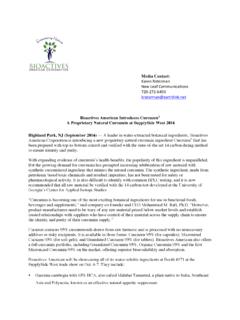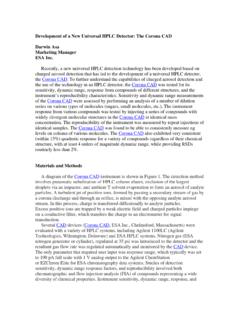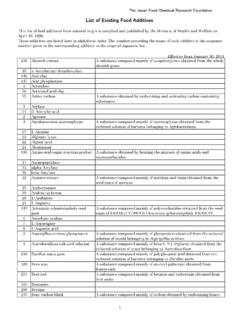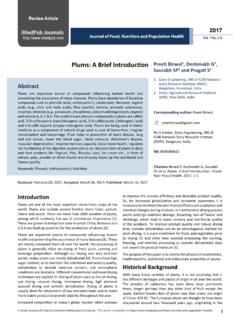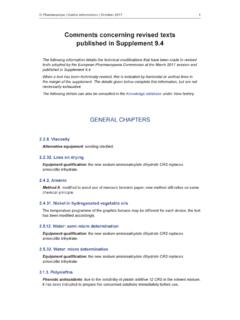Transcription of Assessment report on Cynara scolymus L., folium
1 13 September 2011. EMA/HMPC/150209/2009. Committee on Herbal Medicinal Products (HMPC). Assessment report on Cynara scolymus L., folium Based on Article 16d(1), Article 16f and Article 16h of Directive 2001/83/EC as amended (traditional use). Final Herbal substance(s) (binomial scientific name of the plant, including plant part) Cynara scolymus L., Cynarae folium Herbal preparation(s) a) Comminuted or powdered dried leaves for herbal tea b) Powdered leaves c) Dry extract (DER :1), extraction solvent water d) Dry extract of fresh leaves (DER 15-35:1), extraction solvent water e) Soft extract of fresh leaves (DER 15-30:1), extraction solvent water f) Soft extract (DER :1), extraction solvent ethanol 20% (v/v).
2 Pharmaceutical forms Comminuted herbal substance as herbal tea for oral use. Herbal preparations in solid or liquid form for oral use Rapporteur Dr Ioanna B. Chinou Assessor Dr Ioanna B. Chinou 7 Westferry Circus Canary Wharf London E14 4HB United Kingdom Telephone +44 (0)20 7418 8400 Facsimile +44 (0)20 7523 7051. E-mail Website An agency of the European Union European Medicines Agency, 2012. Reproduction is authorised provided the source is acknowledged. Table of contents Table of contents .. 2. 1. Introduction .. 3. Description of the herbal substance(s), herbal preparation(s) or combinations thereof.
3 3. Information about products on the market in the Member States .. 5. Search and Assessment methodology .. 14. 2. Historical data on medicinal use .. 14. Information on period of medicinal use in the Community .. 14. Information on traditional/current indications and specified substances/preparations .. 14. Specified strength/posology/route of administration/duration of use for relevant preparations and indications .. 16. 3. Non-Clinical Data .. 17. Overview of available pharmacological data regarding the herbal substance(s), herbal preparation(s) and relevant constituents thereof.
4 17. Conclusions on traditional use .. 22. Overview of available pharmacokinetic data regarding the herbal substance(s), herbal preparation(s) and relevant constituents thereof .. 22. Overview of available toxicological data regarding the herbal substance(s)/herbal preparation(s) and constituents thereof .. 24. Overall conclusions on non-clinical data .. 27. 4. Clinical Data .. 27. Clinical Pharmacology .. 27. Overview of pharmacodynamic data regarding the herbal substance(s)/preparation(s). including data on relevant constituents.
5 27. Assessor's overall conclusions on pharmacodynamics .. 27. Overview of pharmacokinetic data regarding the herbal substance(s)/preparation(s). including data on relevant constituents .. 27. Clinical Efficacy .. 27. Dose response 27. Clinical studies (case studies and clinical trials) .. 28. Clinical studies in special populations ( elderly and children) .. 37. Overall conclusions on clinical pharmacology and efficacy .. 37. 5. Clinical Safety/Pharmacovigilance .. 37. Overview of toxicological/safety data from clinical trials in humans.
6 37. Patient exposure .. 37. Adverse events and serious adverse events and deaths .. 37. Serious adverse events and deaths .. 38. Laboratory findings .. 39. Safety in special populations and situations .. 39. Overall conclusions on clinical safety .. 40. 6. Overall conclusions .. 40. Annex .. 41. Assessment report on Cynara scolymus L., folium EMA/HMPC/150209/2009 Page 2/41. 1. Introduction Latin Name: Cynara scolymus L., Asteraceae family (Compositae). In a recent botanical taxonomic revision of the genus Cynara [ESCOP 2009] it has been accepted that the leafy cardoon ( Cynara cardunculus L.)
7 And the globe artichoke ( Cynara scolymus L.) are two cultivars of a new subspecies Cynara cardunculus L. subsp. flavescens Wiklund [ESCOP 2009]. Nevertheless, the botanical name, Cynara scolymus has been kept for the monograph, in accordance with the European Pharmacopoeia ( Cynara scolymus ) not distinguishing morphologically the two types of the plant cultivars (globe artichoke and leafy cardoon). Pharmacopoeial Name: Cynarae folium Other Names: The name has originated from ardi shauki, which is Arabic for ground-thorn, through the Italian: articiocco, English: globe artichoke, French: artichaut, German: Artischocke, Hungarian: artics ka level, Latvian: arti oka lapas, Greek: , Swedish: kron rtskocka, Dutch: artisjok, Portuguese: alcachofra, Croatian: arti oka, Turkish: enginar, Russian: артишок, Spanish: alcachofa, alcachofera.
8 Description of the herbal substance(s), herbal preparation(s) or combinations thereof Herbal substance(s). Pharmacopoeial grade artichoke leaf consists of the dried basal leaves of Cynara scolymus L. containing a minimum of chlorogenic acid (C16H18O9; Mr ) (dried drug). Botanical identification is carried out by thin-layer chromatography, macroscopic and microscopic evaluations, and organoleptic tests. The dried leaf must contain not less than 25% water-soluble extractive [BHP. 1996; Pharmacope Francaise 1987; Blumenthal et al. 2000; Bruneton 1999].
9 Globe Artichoke ( Cynara scolymus L.) is a perennial thistle originating in southern Europe around the Mediterranean (northern Africa and the Canary Islands) [Leung & Foster, 1996]. It grows to m tall, with arching, deeply lobed, silvery glaucous-green leaves 50 80 cm long. The flowers develop in a large head from an edible bud about 8 15 cm diameter with numerous triangular scales; the individual florets are purple. The edible portion of the buds consists primarily of the fleshy lower portions of the involucral bracts and the base, known as the "heart"; the mass of inedible immature florets in the center of the bud are called the "choke".
10 Its cultivation in Europe dates back to ancient Greece and Rome [Grieve 1971]. It is cultivated in North Africa as well as in other subtropical regions [Iwu 1993]. The material of commerce comes as whole or cut dried leaves obtained mainly from southern Europe and northern Africa [BHP 1996]. Artichoke leaf contains up to 2% phenolic acids, mainly 3-caffeoylquinic acid (chlorogenic acid), plus acid (cynarin), and caffeic acid; bitter sesquiterpene lactones of which 47-83% is cynaropicrin; flavonoids including the glycosides luteolin-7- -rutinoside (scolymoside), luteolin-7- -D-glucoside and luteolin-4- -D-glucoside; phytosterols (taraxasterol).










